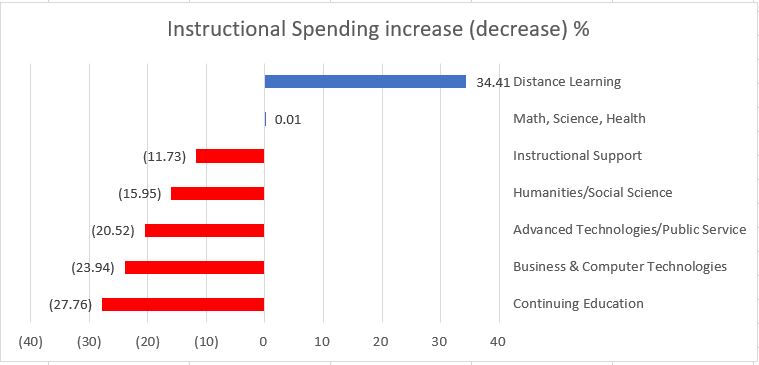Yesterday, I wrote about the change in instructional spending at WCC between 2015 and present. When accounting for inflation, funding for instruction has decreased by 12% in that time. In other words, funding for instruction at WCC has not kept pace with inflation.
But exactly how have the instructional areas at WCC been affected by the failure of the Administration to account for inflation, even while the unduplicated headcount at WCC remained largely the same?
Glad you asked. The chart below shows the final budgets for WCC’s instructional areas for the fiscal years 2015-2022. The figures for 2022 are preliminary, as the college has not yet reported final funding for instruction for FY 2022. Also, the budget for a particular area does not always reflect the actual expenditure for that area. In most years, the actual instructional expenses for most academic areas were below budget.

As you can see, two areas experienced real budget increases: “Distance Learning” and “Math, Science and Health”. A note about Math, Science and Health: In FY 2017, the College began to report Health Sciences separately from Math and Science. For congruency with FY 2015 and 2016, I recombined Health Sciences spending with Math and Science.
Funding for instruction for Distance Learning increased by 34%. “Distance learning” is not actually an academic area in the same way Math Science, and Health are. Since the College reported these expenditures as a subcategory of instructional expenses, I included them in the analysis.
Math, Science, and Health experienced a 0.005% increase in budget between 2015-2022 in real (2015) dollars. The WCC Administration kept the academic instruction budget for this group tied tightly to inflation but made no plan to increase real spending in this area.
Inflationary losses reduces funding for instruction
For all other academic areas, the budgetary picture was not positive, literally or figuratively. Spending on instructional support declined by 11.75% during the period. The funding for instruction in Humanities and Social Sciences dropped by 16%.
Curiously, the funding for instruction in “Advanced Technologies and Public Service” dropped by nearly 21% in real dollars. This line item includes the academic spending for the “Advanced Transportation Center.” This move should raise the question of why we are allegedly funding the construction of a building to house programs that the Administration is cutting the budget for.
Business and Computer Technologies received a 24% budget cut, despite being areas in which graduates are in high demand. Finally, the budget for Continuing Education declined by 28%.
The budget cut for Instructional Support (11.75%) approximately reflected the combined average loss for Instruction (12%). Instructional support – like Distance Learning – is a non-academic area within the Instruction budget. All academic areas except for Math, Sciences and Health, lost real dollars compared to their 2015 budget. And the loss in each academic area was higher than the combined average loss for Instruction.
We have an Administration that does not prioritize Instruction – WCC’s primary purpose. One of two things is at work here: we have a Board of Trustees that does not recognize that the Administration is regularly reducing the instructional budget for most academic areas. Alternately, the Board does recognize the Administration is reducing the Instruction budget and financially rewards the College president for doing so.
The Board is either asleep at the wheel, or they’re deliberately driving WCC off a cliff. As a taxpayer, which do you prefer?
Photo Credit: Jeffrey Zeldman , via Flickr


























